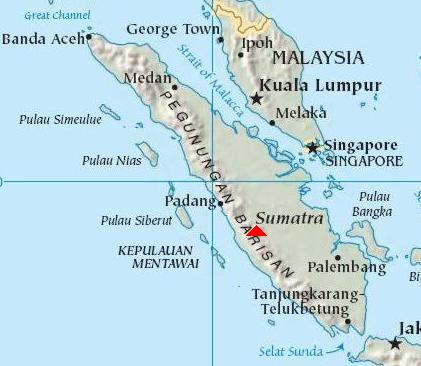
| Gunung Kerinci - Sumatra Highpoint |  |

|
Our goal is seven hours drive southeast; and we agree to a price of 800,000 Rupiah with a man who appears to be some local transportation boss. He hires-out a taxi for us, explaining to the driver our plan and payment amount. We aim to get partway there this afternoon, there being no need for climbing tomorrow as we are on schedule. The auto's air conditioning has failed, and we swelter in the equatorial heat.
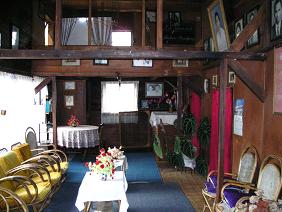
|
| homestay in Alahanpanjang |
The route takes us through progressively higher terrain, and, after some four hours, we stop at a homestay in Alahanpanjang village. Our hosts include a young lady named "Pippet". She is very well trained in English, and is completely embarrassed when I note that her name sounds like a piece of chemistry glassware.

|
| rainbow at Alahanpanjang |
However dinner is the best yet. Ikan bakar ("baked fish") comes as a pair, and the flesh falls off the bone while the skin is black, charred, and crispy. After eating the head and eyes on one fish, my thoughts turn to other items - fried noodles, a huge plate of assorted boiled vegetables, french fries, and much later, hot tea with dessert. I am uncomfortably full.
The next morning a very serpentine road winds past cinnamon gathering operations to the Gunung Kerinci area. We spot it dozens of miles back, yet could not imagine that the distant peak would be our goal. Our road skirts the mountain's east side in a most circuitous path, and eventually we reach Kersik Tua town to its south. I am sick from the winding road, and have tried to sleep for the duration so as to mitigate my queer sense of malaise.
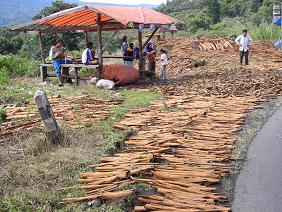
|
| Drying cinnamon bark by the road. |
The mountain lies in great splendor about five miles north across plowed fields that give way to pristine rainforest. It is an impressive sight, rising 7,000 feet, steeply and in a symmetrical fashion, from the adjacent plains. Often hidden by cloud, we catch rare glimpses of the entire mountain only by early morning.
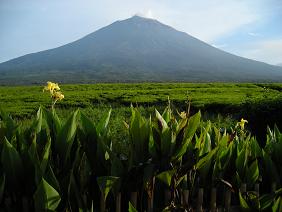
|
|
Rare, cloudless view of Kerinci. Our route parallels the left skyline. |
We locate a man who organizes Kerinci treks. Upon meeting, we are referred to the elderly owner of a homestay along the main street. We agree to 1,000,000 Rupiah, about $110, for a two-day climb of Kerinci with guide and two porters. The owner knows little English, so, again, it is quite convenient that I learned just enough Indonesian to make our desires understood.
The driver refuses to leave without extra payment. We refuse him. Sitting in the homestay, he is willing to wait until hell freezes over. He is a liar, claiming that the quoted price is some 950,000 Rupiah for his services. Both the homestay operator and the trekking agency owner hear this and basically side with nobody. I feel like punching this jackass.
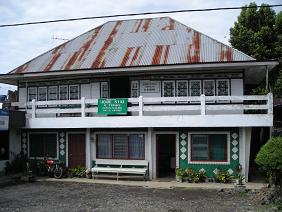
|
|
Homestay in Kersik Tua before and after climbing Kerinci. |
Bob defuses the situation by paying the extra money - as we might be perceived as "bad actors" in the eyes of both other men. We have a stake in maintaining rapport with them until Gunung Kerinci is climbed.
Dinner is set for 6 p.m. in the family kitchen downstairs, and Robert, having gotten soaked during an afternoon of birding, arrives just-in-time.
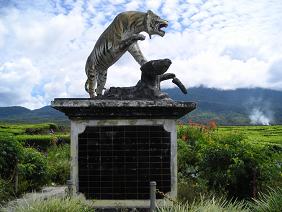
|
|
This Sumatran tiger in Kersik Tua guards the approach road for climbing Gunung Kerinci. |
The next day I am sick with headache. It is the throbbing type, with each footfall bringing pressure to my forehead - and I cannot climb like this. The weather is not cooperating either. We wait one day, using the second of four days planned for "unanticipated events".
Having met our guide the previous day, a nice man of about 30 years, I drive on his motorcycle to the next town west in search of a doctor. The concern is malaria which presents as fever with chills. Although I have no chills, it is four weeks since entering Borneo - exactly the time required for malaria to manifest itself in the body. I lie on this gurney in a hospital, one that is nearly bare of equipment. It is Sunday - and no doctor is available. That's just wonderful - what would somebody do if they have a life-threatening situation today?
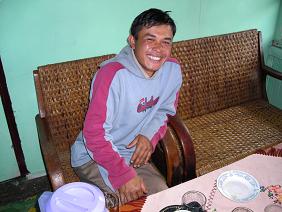
|
| our guide for Gunung Kerinci |
I enjoy ice cream to cheer myself, having zeroed-in on the only freezer in town. Bob joins me, as is his way, as would Robert had he not been off somewhere admiring birds.
In the afternoon we motorcycle the opposite direction to the guide's hometown six miles east. There we find a doctor, but she only has ibuprofen as a pain reliever - not a laboratory with microscope to confirm the malaria diagnosis. I already have ibuprofen, yet buy some anyway to give the appearance of looking appreciative.
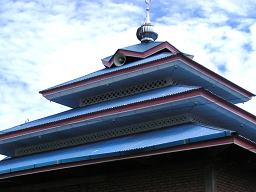
|
|
Mosque roof with loudspeaker for the call to prayer. |
A side-trip with our guide to ride an elephant fails, the huge creatures hiding in the forest beyond a stream crossing I refuse to ford in tennis shoes. Only I elect this option. Later, I visit his home, enjoying hot chocolate on the living room rug with his small children and wife. Bob and Robert are elsewhere, presumably at the homestay.

|
| in Kersik Tua |
My headache wanes, and nearly disappears altogether, on leaving the homestay. It returns upon staying there a while - causing me to consider that I am being poisoned by the ever-present exhaust fumes from passing vehicles on the main road. The homestay has no adequate ventilation, lies along the main road, and there is no other explanation for my observations. I soon forget about malaria, and, much to the surprise of Bob and Robert, eat a decent amount at supper even though I claim to be sick: a truly ill person has little appetite.
Feeling slightly better in the morning, I am nonetheless wary of arising lest that pounding in my forehead return. After a Motrin tablet I feel fair enough to hike - yet I do not want to get out of bed and climb yet another 7,000 vertical feet.

|
| aquamarine butterfly |
Bob now has a sinus and chest cold - and, indeed, this journey is wearing down all of us.
A car holding all six of us is unavailable. Plan B goes into action - and the guide amasses enough motorcycles for each person to ride separately the three miles to road's end at mountain's base. We pass an enormous tea plantation, which is novel because tea is a crop rarely seen in America.
We hike around eight, soon finding ourselves amidst virgin rainforest. The growth is thick, the air is hot and sticky, and the experience is, in a word, unique and independent of climbing any peak. After two hours we hear monkeys in the distance, and this is our closest approach to seeing large wildlife. There were also monkeys along the main road near Mataram on Lombok.
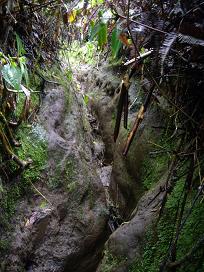
|
|
The Kerinci trail is this muddy trench. |
After some 3,000 vertical feet the route, basically a muddy path, changes character from reasonably broad surface to a narrow trench with high walls of mud on either side. To make progress one must often "climb" by grabbing tree roots, pulling yourself up, often with some exposure (an arm or leg is easily broken), until the next semi-level stretch.
The guides and porters take this in-stride, and so do we after similar experiences at Gunung Agung. However Kerinci takes the cake insofar as rudimentary, narrow, steep jungle paths. Our local helpers, guide and porters alike on all mountains, are invariably in excellent condition; managing to carry heavier loads than our small daypacks despite being short, skinny - and, most remarkably, they all smoke. The single exception is our guide on Kerinci, a devout Muslim, who has not succumbed to this terrible national obsession.
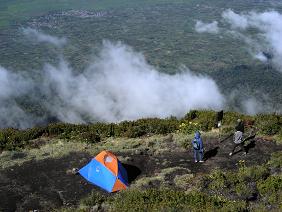
|
|
Looking down to high camp with a community far, far below. |
We reach high camp at about 10,600 feet - only 1,400 feet beneath the summit. It is just above the shrubline and so it is cold and quite windy. It is windy enough that the guide assists me in repositioning my tent to another, nearby location that is slightly sheltered from the worst of it. I am amazed to learn that the guide and porter have no tent. Intead, they will sleep in plastic bags to stay warm - makeshift 'bivvy sacks.
Robert had pulled ahead and, in a show of great eagerness, has already reached the summit. He returns in the late afternoon, and, ostensibly to take photos of us, will reclimb with Bob and myself in the morning.
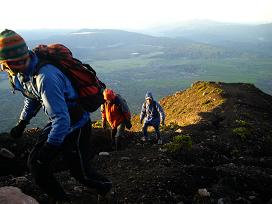
|
|
Hiking Kerinci's volcanic slopes above high camp. |
We start around first light, and the going is cold and windy for much of the climb. In fact, it is uncomfortably cold - but not bitterly cold. Cold enough to wear gloves and multiple layers. Not cold enough to worry about frostbite. Relief is found by remaining inside gulleys formed by erosion within the volcanic material.
Robert and I summit in roughly 90 minutes, Bob coming perhaps a half hour later with our guide. We wait for him, as always - but especially this time since we have now completely succeeded in our principal goal of climbing all four Earth Fifty Finest peaks. Bob is elated.
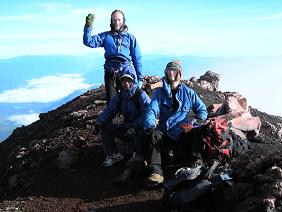
|
|
Robert (standing), guide (left, seated), and Adam at Kerinci's summit. Cold. |
The views are spectacular, as we see dozens of miles in many directions, plus several thousand feet below to much more than just one town and village. It is lushly verdant in the valleys; there are lakes, farm fields, towns - and all far, far below.
Satisfaction fills me. Everything is so peaceful, so green, so removed from the concrete and asphalt of San Diego. I am here, at the top of Sumatra halfway around the world!
Atop the final, hardwired goal of our five week odyssey I am reluctant to leave. Yet descend we must, and, a short hour or so later we are back at camp under a rapidly warming day.
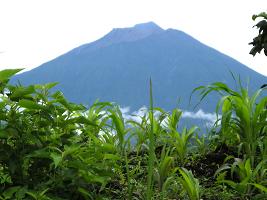
|
| Gunung Kerinci and native vegetation |
We break camp by about 10:30 a.m. and descend, carefully at times through the mud trenches, all the way to base. We anticipate rain as with nearly all afternoons, but are somehow spared this indignity as we approach pavement at the edge of plowed fields.
I insist that Bob do his jig that is reserved for very special successes. He does this, trotting in a circle and shouting as Robert films.
We return to the homestay for a third night. On my suggestion an omelette with fried potatoes is our main dish - a frittata; other foods, plus much rice, fill the tabletop.
I stress to the lady of the house, who has "connections", how important it is for us to arrange transportation the next day.
Fortunately, a man and his minivan appears for the eight hour drive north to our next venue - the city of Bukittinggi ("high hill") and its pair of nearby ultra prominence summits.
The guide bids us farewell while giving me an Islamic prayer cap. Having become friends, we pledge to not forget each other despite great distance. As he knows I am Jewish, the guide clearly makes the distinction between one's religion and one's character.
Our goals are basically overwith, the remaining time used to climb extra mountains not on the original itinerary.
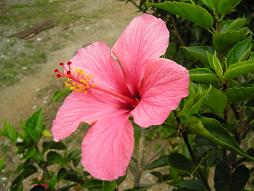
|
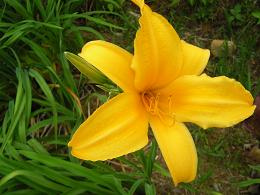
|
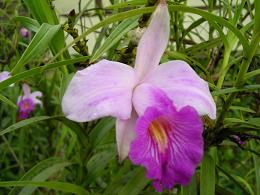
|
| A trio of bright flowers - Sumatra. |
| previous page - Gunung Slamet | next page - Bukittinggi, Birthday, and Two more Volcanoes |